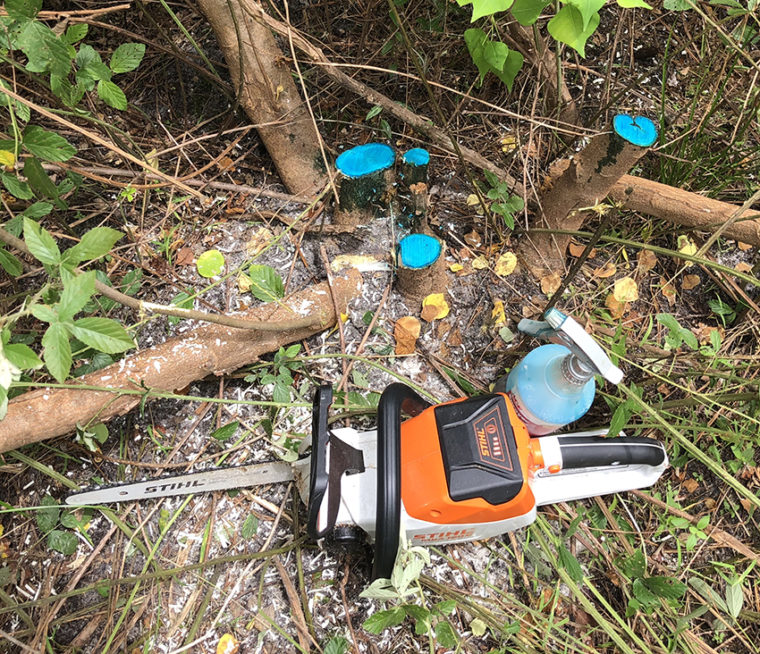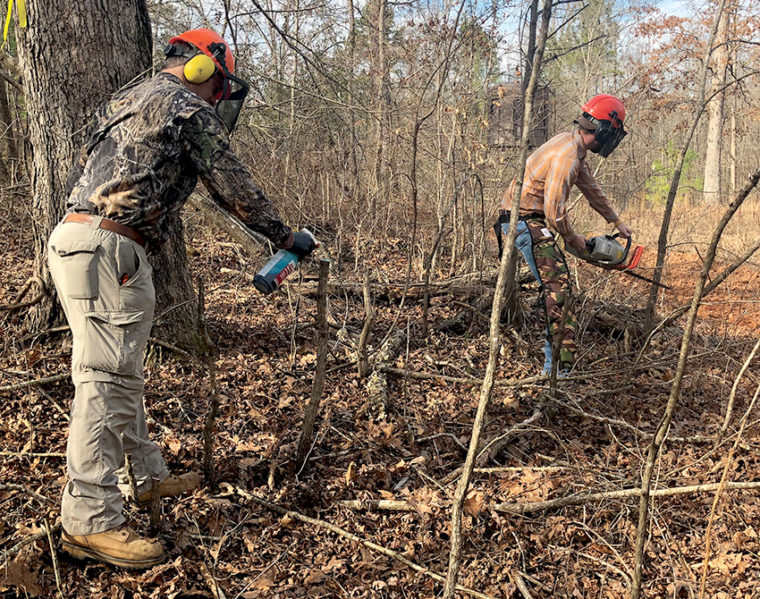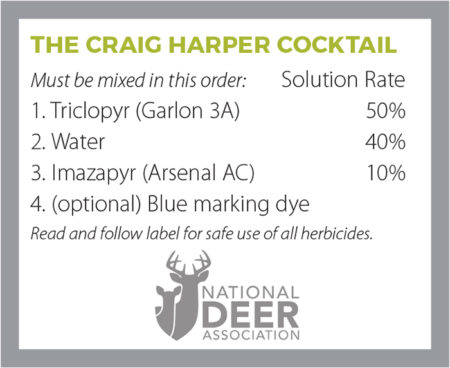Removing surplus or non-native trees and shrubs to restore sunlight to the ground, fueling a rebirth of deer forage and cover, is a great way to rapidly improve deer habitat. Dr. Craig Harper of the University of Tennessee calls the technique Forest Stand Improvement (FSI), but it’s not as simple as cranking a chainsaw and dropping the nearest tree. Selecting the right trees to remove and to leave is very important.
In Part 1 of this two-part article, I talked about that selection process. If you didn’t read it yet, start there. I’ll pick up from the end of that article by going into greater details about tools, techniques and other things I’ve learned through experience.
The Ideal Saw
In a word: lightweight. The best chainsaw for this work is one that will not wear you out. You’ll be on the move constantly in your selected FSI patch, girdling large trees and dropping smaller ones, so a smaller, lighter saw designed for pruning and light yard work will be best, because you’ll be able to work longer without needing to rest.
Personally, I use a Stihl MSA 120-C, which is a cordless saw with a rechargeable battery. It weighs only 8.4 pounds. I have worked steadily with it in the woods for over 2½ hours without needing to recharge, and it is excellent for girdling trees. It can do anything I need except felling cuts on very large trees, but that’s rarely necessary in FSI. You can see it in the photo below with the stumps of an invasive Chinese tallow tree I killed.

A lightweight saw like this Stihl rechargeable is ideal for FSI because you can work longer in your FSI patch without needing to rest.
The Girdling Technique
Step up to the tree while standing (there’s no need to girdle the tree down low unless it’s forked low, and it’s less safe to run a saw while bending). Holding your saw at a comfortable height, place the top of the bar against the tree. This way, you are cutting with the side of the chain that is moving away from you, which pulls the saw bar into the tree instead of pushing it toward you. It also sprays wood chips away from you.
Holding the saw firmly in both hands, walk around the tree while cutting a shallow groove. You don’t need to push or try to cut deep; the pull of the saw will take care of this. You only need to cut into the cambium layer, just inside the bark. Connect the ends of the girdle to completely sever the cambium layer.
Always make sure you have a clear path completely around the tree before you start cutting. You don’t want to trip, stumble or get tangled in vines and fall with a running chainsaw in your hands. Some trees are crowded among other trees and impossible to girdle easily, and you may have to finesse the work. Take your time, and be careful. Kickback often happens when a running chain contacts another object you aren’t aiming to cut, especially at the nose or end of the saw bar.
Girdling takes a little practice. It doesn’t require a lot of force or throttle unless your saw is extremely dull. After a few tries, you’ll be doing it quickly and easily, but always put safety first. The short video below shows you the girdling technique and just how quickly a two-person team can girdle and treat a single tree (about 15 seconds).
Two-Person Teams
You can do FSI alone, but you’ll have to swap constantly between the saw and the squirt bottle. I’ve found FSI goes much faster for a two-person team: one to operate the saw, one to treat trees with the squirt bottle.
With two-person teams, stay in close proximity, because you’ll need to communicate. If you identify and cut a tree to make a mineral stump (see Part 1), you don’t want your partner to spray the stump with herbicide. Since everyone should be using hearing protection around the chainsaw, a signal system is helpful.
If you’re the saw operator, be mindful of your partner’s location when dropping any small trees to the ground. If you’re the squirt-bottle operator, be mindful of wind direction: Don’t drift herbicide mist into your own face or downwind into your partner’s. Of course, don’t spray herbicide in high winds, but there is almost always a slight breeze that may cause some drift.
Both team members should be wearing helmets with face-screens, hearing protection and gloves. Whoever uses the saw should be wearing chainsaw-proof chaps. Whoever uses the squirt bottle should be wearing disposable latex gloves and eyeglasses in addition to a face screen.

Dr. Craig Harper has a new 36-page booklet on FSI, available for $10 from the University of Tennessee. Click the image to order.
How Much Sunlight Do You Need?
As you’re working in your FSI patch, you’ll ask yourself: When do I stop killing trees? Craig said his work indicated 20 to 30% sunlight is necessary to stimulate a significant understory response. Mark Turner of Auburn University documented a 500% increase in forage with a 30% reduction of tree canopy. You’ll get more forage and cover up to about 70 to 80% canopy reduction, and the more space you put between the oaks you leave, the more acorns they’ll produce.
But it may take some time for you to learn to evaluate how much sunlight you’ve restored. I learned one thing when I first tried FSI: When I had the sense I had killed “enough” trees in a certain spot, I was usually wrong. Come leaf-out in spring, trees expand to fill the new space, and limbs now heavy with leaves bend outward to create a much larger shade footprint than you guessed when you were looking at a bare tree in winter. I found myself wishing I’d killed more trees.
Still, don’t overdo it. Cut and kill trees until you feel you have done enough, then review your work in the growing season. You can always return and kill more trees, but it’s a lot harder to put a tree back.

This patch in Georgia was choked and shaded by sweetgums and other overabundant native and invasive trees. One year after FSI, the new sunlight produced an explosion of forage and cover.
Best Time of Year
As far as herbicide effectiveness, the old wisdom is that you shouldn’t use hack-and-squirt in spring when the sap is rising. But according to Craig Harper, this is only true for a few species of trees that are heavy sap producers in spring, such as sugar maples. If you girdle a tree and see sap flow from the cut, this can flush out the herbicide. Otherwise, the herbicide still works on trees in spring.
The best time to do FSI is any time you can. It works year-round.
If you girdle-and-spray trees in winter when they are dormant, most will not green up the following spring. If you do it during the growing season, some will die quickly but most will struggle on through the rest of the year, lose their leaves in fall, and then die.
Working in the comfort of cool weather is nicer than the heat of summer, but it’s easier to identify trees in summer. Otherwise, the best time to do FSI is any time you can. It works year-round. Keep a squirt-bottle handy all year long. At any time you might spot a single invasive tree you want to kill, and you don’t need to plan a special weekend for that.
Best Herbicides
Craig began leading research on killing trees with herbicides in the late 1990s. He soon learned that certain herbicides are ineffective on some tree species, but he didn’t want to carry multiple squirt bottles in the woods. So, he experimented with blends. He discovered what I call the “Craig Harper Cocktail.” Here’s the recipe and instructions.
Garlon 3A (triclopyr) is less effective on some species including hickory and sourwood. Arsenal AC (imazapyr) is less effective on locusts, redbud, elm and hophornbeam. When you combine them, their strengths and weaknesses overlap, and you can kill any tree you encounter.
Before you go shopping prices on these herbicides, let me prepare you. The price tags are not cheap, but the good news is that they go a long way. And there are some ways to economize if you need to. Let’s do some math.
Of the two, imazapyr is more expensive. A 2½-gallon jug of Arsenal AC runs around $460, however it makes up only 10% of the recipe – that size jug will make 200 16-oz. spray bottles of Craig’s cocktail.
Triclopyr is around $150 for a 2½-gallon jug, which mixes 40 squirt bottles. To use up an entire jug of Arsenal AC on 200 squirt bottles, you’d need five jugs of Garlon 3A. Grand total, about $1,200. But those 200 squirt-bottles worth of blend will treat a lot of area. Working hard for an entire day with a two-person team, you’d probably use two bottles with approximately $6 worth of herbicide in each, but that can vary with average tree size and density. The bottom line is, your cost per acre treated will be very low, so don’t let the initial investment scare you off.
A 50/50 blend of Garlon 3A and water will still kill a lot of tree species effectively, and if you need to minimize expenses, skip the imazapyr. If you have a lot of hickory or sourwood trees that need to be thinned, though, you’ll have to fell them completely.
In the photos on this page, you’ll notice my herbicide blend is blue, which comes from a dye added separately. Adding blue colorant to your cocktails helps you keep track of what’s been treated, and I recommend using it, especially with two-person teams.
As always, read and follow the label of these and any other herbicides you use.

You only need to spray enough herbicide in a girdle to wet the exposed wood. If herbicide is dripping down the tree, reduce the amount applied or adjust the spray/mist nozzle.
Non-Target Effects?
Imazapyr is soil-active, so one of the questions often asked about the Craig Harper Cocktail is whether it kills nearby non-target trees. No – not in the small amounts applied to a girdle or stump. This technique is a surgical strike on individual trees using minuscule doses of chemical.
In his study, Mark Turner applied FSI to four, 8-acre patches (32 acres total) using Craig’s herbicide blend. Gathering data afterward, he documented only one case of non-target mortality out of 440 trees sampled, and it was a non-treated sweetgum tree located next to a treated sweetgum. Like aspens, sweetgums can clone themselves by sprouting from their roots, so nearby trees are usually clones sharing one root system. Most tree species, including oaks, do not do this. Unless you somehow spill significant amounts of imazapyr on the ground in your work area, evidence suggests you will never see non-target mortality using stump-treatment or girdle-and-spray at these rates.
Craig said he has never witnessed non-target tree mortality, except for cloning species, in his years of research.

Sweetgum trees clone themselves by sending up root sprouts, so a cluster of trees is often clones of one tree. When these stumps were treated with herbicide, they died, but so did the sweetgums within feet just behind them, because they shared a root system. This will not happen with non-cloning species like oaks.
Raise your squirt bottle for a toast
Opening your woods to sunlight is the best way to rapidly increase quality forage and cover while also enhancing mast production, and Craig’s chainsaw approach makes it easy for one person to make a big difference. So, start making your plans now. Draw up your patches on a map, prepare your firebreaks, purchase herbicide and squirt bottles, and start FSI. At the end of the work, we’ll put down our squirt bottles full of Craig Harper’s Cocktail and toast our mutual success with a different kind of cocktail!

